Courtesy of Gary Hall Sr., 10-time World Record Holder, 3-time Olympian, 1976 Olympic Games US Flagbearer and The Race Club co-founder.
It is a marvel to watch Caeleb Dressel swim. He does many things better and faster than any other swimmer in history. Mostly because of his incredible propulsion off the blocks and a fast dolphin kick, he beats everyone on the start…by a lot! I love his high octane, vertical recovery with full forward extension of the arms at entry, his forceful hand entry with fingers and thumbs squeezed together, his semi-deep pull, his fast stroke rate and his outrageously strong kick. He also uses some different techniques throughout the race that are not so obvious.
In analyzing the underwater video of Caeleb from Tokyo from his 21.07 winning time in the 50 meter freestyle, here are five subtle techniques that he uses that you may never catch, but they might have also helped propel him to victory.
Technique #1. Caeleb holds his legs straight back on the dive after the entry
The first down kick of dolphin starts after the feet enter the water on the start. Nearly all swimmers press the legs and feet through the water hard on that entry kick, initiating the up kick with their feet well below their body line. Not Caeleb. He holds his legs straight with toes pointed, what I refer to as a check swing, initiating the first kick propulsion after a short glide with an up kick, not a down kick.
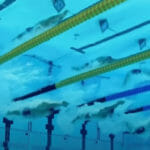
Caeleb holds the legs straight back with toes pointed after entry, pausing briefly before the first up kick
Technique #2. Caeleb initiates his first freestyle pull with the final dolphin up kick
Most of the sprinters I have observed will initiate the first freestyle pull with the final down kick, but Caeleb begins pulling one step earlier with the final up kick and before his final down kick. Bruno Fratus starts his first pull on the final up kick, but then goes right into freestyle kick, omitting a final down kick. Bruno also takes just four down kicks to breakout. Caeleb takes six down kicks and Florent Manaudou takes seven down kicks to breakout, initiating his first pull on the final one.
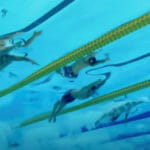
Caeleb initiates his first pull with his right hand on his final up kick, not the final down kick
Technique #3. Caeleb tilts his head slightly forward during the swim
As far as I am concerned, there are only two good options for the head position in sprint freestyle- in alignment with the upper body (looking straight down) or tilted forward slightly. Caeleb tilts his head forward slightly while Bruno and Florent hold their heads in alignment, looking straight down. The differences in head positions alter the frontal drag and the propulsion forces. Head down causes less drag. Head tilted forward enables the swimmer to generate more propulsion. Which technique works better for each swimmer is likely different.
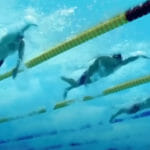
Caeleb (leading) tilts the head forward slightly, while Manaudou and Fratus (adjacent) are looking straight down
Technique #4. Caeleb’s surge kick occurs on the same side of his hand entry
Even in a sprint 50 meter freestyle, the intensity of the down kicks are not equal. Of the six down kicks that occur within each swimming cycle (three on each side, hand entry to hand entry), the most forceful one is timed with the hand entering the water. We call it the surge kick. Most swimmers use the opposite leg to generate this surge kick, but Caeleb uses the leg on the same side of his hand entry to surge with.
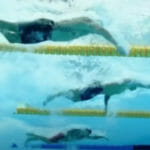
Caeleb uses his surge kick on the same side of his hand entry, while Manadou surges with his opposite leg down kick
Technique #5. Caeleb’s pulling wrists go through a greater range of motion than any other swimmer
Most sprinters will keep their wrist pretty stiff throughout the early part of the pulling cycle, maintaining the hand and forearm in the nearly the same alignment. Near the end of the pull, all sprinters extend their wrists back to maintain greater propulsion force. Caeleb flexes his wrist more than others in the early lift and propulsion phases of the pull (fingers pointing down). Then, just before the hand reaches his shoulder on the way back, he extends the wrist earlier than others in order to maintain a more perpendicular plane with his hand through the pull, to generate more propulsion. The amount of motion of his wrist from flexion to extension during the pull is considerably more than all of the other sprinters. 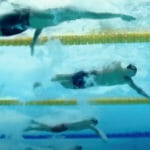
Caeleb flexes his wrist early in the pull and gets his fingers pointing downward to help with propulsion
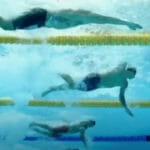
Caeleb extends his wrist back even before reaching his shoulder to help sustain the propulsion
It takes more than a great start to become the fastest freestyle swimmer in history. Caeleb Dressel certainly has more than a great start. He is a very intuitive swimmer, very cerebral and he thinks a lot about the details of his swimming techniques. I am not sure how much these five particular subtle techniques contribute to his success, but they are certainly worth noting.
Yours in swimming,
Gary Sr.
Like The Race Club on Facebook
Follow The Race Club on Instagram
Follow The Race Club on Twitter
Connect to The Race Club / Gary Hall Sr. on Linkedin
THE RACE CLUB
Because Life is Worth Swimming, our mission is to promote swimming through sport, lifelong enjoyment, and good health benefits. Our objective is for each member of and each participant in The Race Club to improve his or her swimming performances, health, and self-esteem through our educational programs, services and creativity. We strive to help each member of The Race Club overcome challenges and reach his or her individual life goals.
The Race Club provides facilities, coaching, training, technical instruction, video, fitness and health programs for swimmers of all ages and abilities. Race Club swim camps are designed and tailored to satisfy each swimmer’s needs, whether one is trying to reach the Olympic Games or simply improve one’s fitness. Our programs are suitable for beginner swimmers, pleasure swimmers, fitness swimmers, USA swimming or YMCA swimmers, or triathletes; anyone who wants to improve swimming skills. All of our Race Club members share an enjoyment of being in the water and use swimming to stimulate a more active mind and body.


